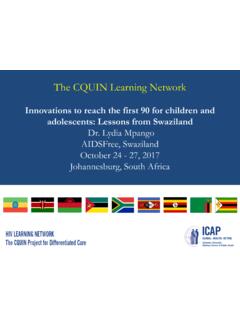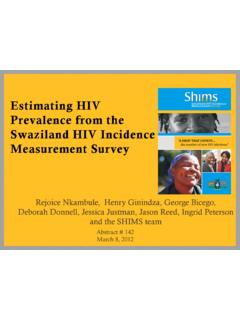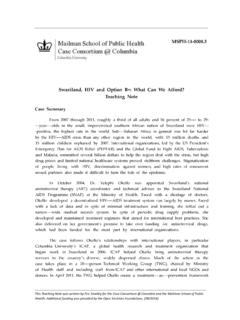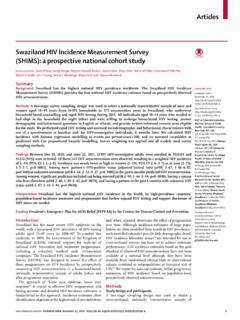Transcription of SWAZILAND HIV ESTIMATES AND PROJECTIONS REPORT …
1 I The Kingdom of SWAZILAND SWAZILAND HIV ESTIMATES AND PROJECTIONS REPORT JULY 2010 ii Table of Contents List of iii List of Figures .. iii FOREWORD .. iv ACKNOWLEDGEMENTS .. v OVERVIEW .. 1 THE PROCESS AND METHODOLOGY OF DERIVING ESTIMATES AND PROJECTIONS .. 3 The Methodology .. 3 Rationale for Estimation and PROJECTIONS .. 5 SPECTRUM Outputs .. 6 1. RESULTS .. 6 hiv incidence .. 6 hiv incidence Rate among 15-49 years .. 6 Number of new HIV infection in Children (0 -14 years) .. 7 Adult (15-49) HIV Prevalence .. 8 Number of people living with HIV .. 10 HIV population: adults (15+).
2 10 HIV population: children (0-14) .. 11 Adult and children: need for treatment .. 11 Adults (15+): need for 11 Pediatric ART and Prevention of Mother to Child 12 AIDS deaths .. 14 Impact of ART on Survival of PLHIV .. 15 Orphans .. 16 2. SUMMARY AND CONCLUSION ..18 Bibliography and References .. 19 Annexes: .. 20 iii List of Tables Table 1: Highlights of the health and socio-economic indicators .. 1 Table 2: New Infections: Children (0-14) .. 8 Table 3: Number of New Infections among Infants (Under 1) .. 8 Table 4: HIV Population, population in need of ART 2008-2015 .. 11 Table 5: Projected number of HIV+ pregnant women in need of PMTCT.
3 13 Table 6: HIV population for children 0-14 years, in need of ART and Cotrimoxazole .. 13 Table 7: ALL Orphans and AIDS orphans .. 17 Table 8: Summary Data on HIV population, adults and children in need and receiving ART, children receiving Cotrimoxazole, mothers needing and receiving PMTCT .. 20 Table 9: Summary data on New Infections among adults and children, AIDS Deaths and Orphans .. 20 List of Figures Figure 1: HIV Prevalence among ANC Clients .. 2 Figure 2: HIV Prevalence, Women and Men by Age, SWAZILAND 2007 .. 2 Figure 3: Trends in hiv incidence .. 7 Figure 4: Projected number of New Infections (15-49), 2008-2015.
4 7 Figure 5: Estimated National HIV Prevalence .. 9 Figure 6: Estimated Regional HIV Prevalence .. 9 Figure 7: Projected Adult Prevalence (15-49) 2008-2015 .. 10 Figure 8: Number of People living with HIV aged 15 and 10 Figure 9: Number of Children (0-14) living with HIV .. 11 Figure 10: Adult HIV Population 15+ in need of ART .. 12 Figure 11: Projected Number of AIDS deaths among adults and children 2008-2015 .. 14 Figure 12: Total Number of AIDS Deaths among Children and Adults 2008 2015 .. 14 Figure 13: Annual AIDS deaths by Sex, Children ..15 Figure 14: Annual AIDS deaths by Sex, Adults 15+ ..15 Figure 15: Projected annual AIDS deaths with and without ART (CD 4 < 350).
5 16 Figure 16: Projected annual AIDS deaths with and without ART (CD 4 < 200) ..16 Figure 17: ALL Orphans and AIDS orphans .. 17 iv FOREWORD In recognition and commitments to the Millennium Development Goal 6 as well as the Universal access targets, SWAZILAND has set an ambitious target of reducing hiv incidence from percent to percent by 2014 (NSF 2009-2014). As a country with the highest HIV prevalence in the world, (26% among the 15-49 age groups) SWAZILAND has witnessed a dramatic fall in life expectancy from 60 years in 1997 to years in 2008, a rising number of orphaned and vulnerable children as well as other devastating social and economic impacts of the AIDS epidemic.
6 To rise to this challenge, stakeholders to the AIDS response, both local and international have responded by developing an evidence informed and results based National Strategic Framework with greater emphasis on targeted prevention interventions, a Health Sector Response plan whose goal is to attain universal access coverage in treatment care and support, and commitment in terms of resources and political will. With better understanding of the major drivers of the epidemic including deepened analytical work on know your epidemic and know your response commonly termed the modes of transmission study, combined with a scientific approach to target setting, it is believed that the nation will make progress towards mitigating the impact of AIDS.
7 The SWAZILAND HIV ESTIMATES and PROJECTIONS REPORT 2010, is one of the main information products generated by a broad range of partners, to assist the country assess progress towards attainment of MDG s and the country s universal access targets. Every two years, the ESTIMATES and PROJECTIONS team in the country undergo a regional training supported by UNAIDS,WHO and PEPFAR, after which they populate the two models, SPECTRUM and ESTIMATES and PROJECTIONS Package (EPP) with country data to generate ESTIMATES of the population in need of various services. These data assist government, civil society, NGO s development partners and stakeholders to establish the reach of their intervention and collectively to monitor and evaluate the impact of HIV interventions including progress towards national and international commitments such as NSF targets, NDS, HSRP, MDG Universal Access and UNGASS.
8 Furthermore, the data contained in this REPORT is intended for programming for HIV both now and into the future. While the current ESTIMATES indicate some positive progress particularly in the scale up of PMTCT and ART services. Both the 2007 and 2009 HIV estimation and PROJECTIONS reports indicate that progress has been made in responding to the HIV epidemic; particularly in scaling up efforts in treatment, care and support, but that the prevalence rates might not change significantly unless the prevention tap is tightened further. The data in this REPORT are by no means conclusive and are therefore subject to change depending on future policy decisions around the eligibility criteria, change of drug regimen, revisions and assumptions in future EPP and SPECTRUM tools.
9 Derek von Wissell NERCHA Executive Director v ACKNOWLEDGEMENTS This resourceful REPORT is a culmination of the continuous efforts by the country s HIV ESTIMATES and PROJECTIONS core team comprised of personnel from the NERCHA, Ministry of Health, Central Statistics Agency, WHO, and UNAIDS. The time and expertise they dedicated to generating these ESTIMATES and PROJECTIONS is highly appreciated. The National Emergency Response Council on HIV and AIDS (NERCHA) is indebted to UNAIDS for providing training and the technical support that made this very important exercise a reality.
10 In particular, we are indebted to Eleanor Gouws (UNAIDS), Peter Ghys (UNAIDS), John Stover (Futures Group Institute) and Mary Mahy (UNAIDS) for their invaluable guidance during the analytical phase of this work. We would especially like to thank the Ministry of Health (MOH) and other partners including CSO, WHO and UNAIDS for this collaborative effort and for their invaluable participation. This REPORT would not have been made possible without the cooperation of all Swazi s who regularly and willingly participate in Census and other surveys such as the ANC, DHS, including service providers who submit data on the coverage of services.










